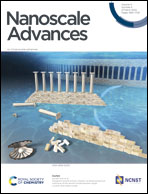Designed nanostructures created via physicochemical switching of the growth mode between single crystals and mesocrystals†
Abstract
Most biominerals are composed of mesocrystals, in which individual nanoparticle building units have a defined long-range order on the atomic scale in at least one direction. Although the crystal size and orientation of the mesostructures are spatially designed in biological architectures, it has been difficult to achieve adequate control of the crystal growth to produce modulated mesostructures in artificial aqueous systems. Here, we propose a simple physicochemical approach for the spatial design of nanostructures using an aqueous solution system. The ordered arrays of oriented fluorapatite (FA) rods similar to tooth enamel are produced on a polymer substrate in a supersaturated solution. We succeeded in reversible switching of the growth mode of FA between single-crystalline rods and mesocrystalline grains through the disturbance of the solution. The primary crystal size was tuned between micrometric rods ∼0.5 μm wide and >5 μm long and nanoscale grains ∼10 nm wide and 50 nm long without a drastic change in the c direction. Hierarchical architectures consisting of iso-oriented FA microrods and nanograins were constructed via temporal control of the crystal growth mode by switching a physicochemical parameter, such as the degree of supersaturation at the growth front.



 Please wait while we load your content...
Please wait while we load your content...